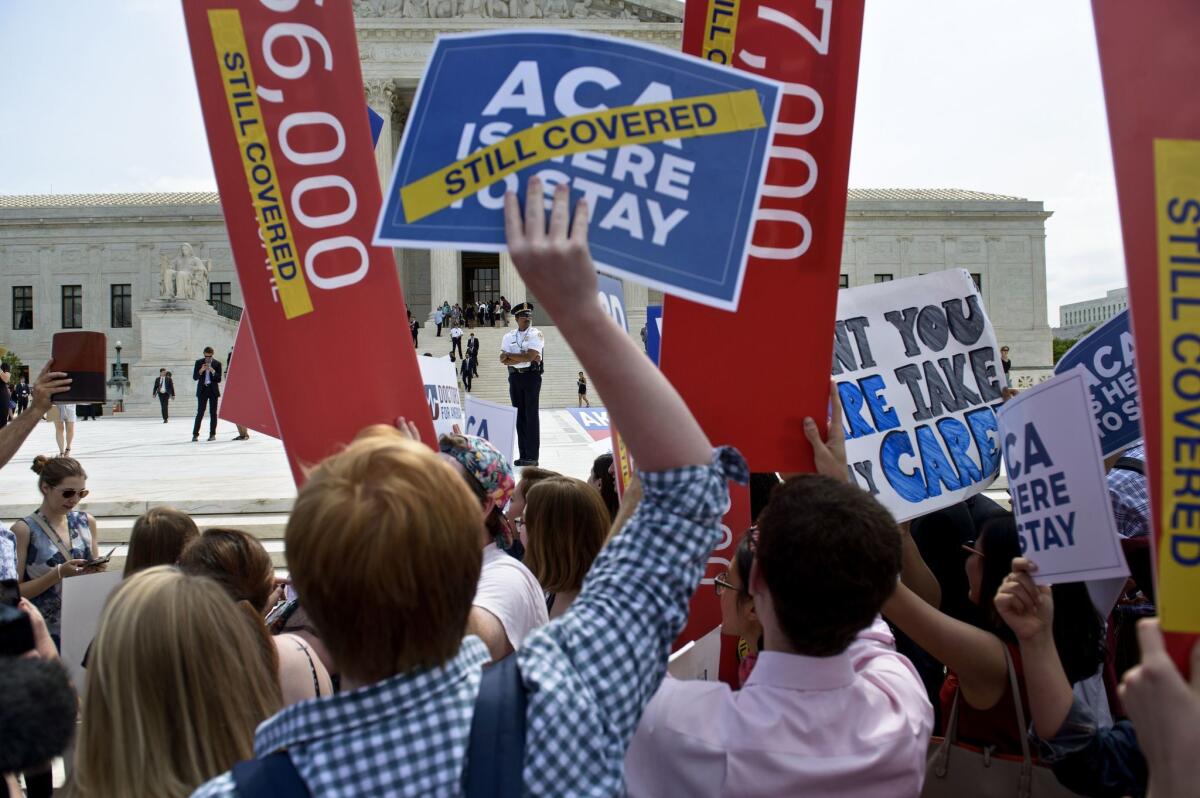Column: One-sixth of Americans have trouble paying medical bills. That’s good news.

Supporters of the Affordable Care Act rallied outside the Supreme Court in June as the Court upheld a key provision of the act.
- Share via
The U.S. government reported Tuesday that some 44.5 million Americans experienced problems paying their medical bills in the first half of this year. That may not sound encouraging, but perspective is everything: In 2011, the figure was 56.5 million.
Overall, the percentage of people living in families facing trouble with their medical bills fell to 16.5% in the first six months of 2015 from 21.3% in 2011. The reason for the steady, linear drop in financial stress in strain from medical bills is inescapable. It’s the Affordable Care Act.
The government figures, from the National Center for Health Statistics, show the sharpest drop for Americans in public healthcare programs, to21.8% this year from 27.8% in 2011. That’s likely an artifact of the expansion of Medicaid under the ACA. But even those in uninsured families had less trouble with bills--that figure dropped to 29.8% from 25.7%. That could be a sign of the general moderation of medical inflation since the enactment of Obamacare, as well as of an improving economy.
The trend is another sign that the ACA has worked itself into the fabric of medical care in the U.S., which makes the latest vote by congressional Republicans to repeal the law all the more fatuous. There’s much more to the ACA than the individual mandate to obtain coverage or the insurance exchange system, the prime targets of its opponents.
The law has begun to change physician and hospital practices materially, leading to a slowdown in cost increases and to better outcomes. A good example of the latter comes from figures on hospital errors recently released by the Agency for Healthcare Research and Quality, or AHRQ, a unit of the Dept. of Health and Human Services. (H/T to Jonathan Cohn of the Huffington Post.)
The agency reports that “hospital acquired conditions” have shown a “sustained 17 percent decline from 2010 through 2014. That translates into 87,000 deaths averted, and 2.1 million injuries, or “harms,” over that period due to the reduction in errors. The largest single category of reduced errors is in adverse drug events, accounting for nearly 40% of the total.
The role of the ACA in this trend is rather more nebulous than its effect on the pressures of medical bills, but the bulk of the improvement has occurred since the law’s enactment, and may reflect initiatives for improving hospital care that were written into the ACA; among them is reduced Medicare reimbursements for institutions with high rates of readmissions. David Blumenthal, president of the Commonwealth Fund, told Cohn that the decline in errors is “historic” and unprecedented in U.S. medical history.
That said, there still is room for vast improvement. “Much work remains to be done to ensure that the U.S. health care system is as safe as it can possibly be,” the AHRQ report states. One cause for concern: The reduction in hospital errors plateaued in 2014 at 17% below 2011, unchanged from 2013.
There’s no question that Obamacare is saving Americans millions of dollars in medical costs. As Cohn says, it also “may literally be saving lives.” In that context, yet another vote by congressional Republicans to turn the clock back to the pre-ACA era of healthcare in U.S. seems more than foolish.
Keep up to date with Michael Hiltzik. Follow @hiltzikm on Twitter, see our Facebook page, or email [email protected].
More to Read
Inside the business of entertainment
The Wide Shot brings you news, analysis and insights on everything from streaming wars to production — and what it all means for the future.
You may occasionally receive promotional content from the Los Angeles Times.











